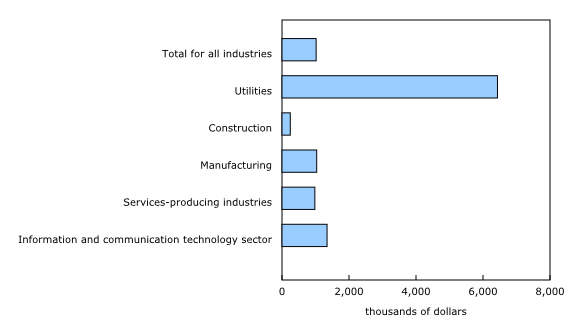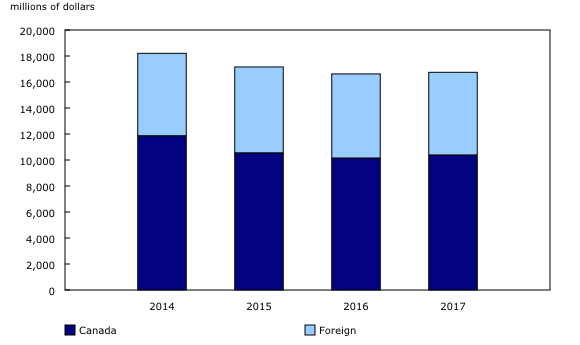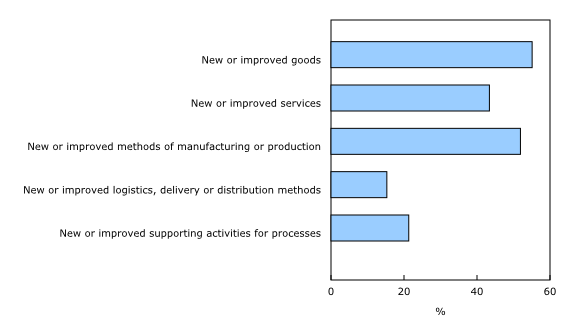Industrial research and development characteristics, 2015 (actual), 2016 (preliminary) and 2017 (intentions)
Archived Content
Information identified as archived is provided for reference, research or recordkeeping purposes. It is not subject to the Government of Canada Web Standards and has not been altered or updated since it was archived. Please "contact us" to request a format other than those available.
Released: 2017-12-18
In-house industrial spending on research and development declines in 2015
In-house industrial research and development (R&D) expenditures declined 5.8% to $17.2 billion in 2015, down from $18.2 billion in 2014. Businesses in Canada intended to spend $16.6 billion on in-house industrial R&D in 2016 and $16.7 billion in 2017.
Spending on in-house industrial R&D by the oil and gas extraction industry fell 32.2%, from $1.3 billion in 2014 to $912 million in 2015, in tandem with lower crude oil prices.
Services-producing businesses continued to be responsible for over half of all in-house industrial R&D expenditures in 2015 at $9.5 billion. Manufacturers performed just over one-third ($6.2 billion) of in-house industrial R&D in 2015.
Current and capital in-house R&D spending declines
Capital in-house industrial R&D expenditures declined to $1.0 billion in 2015 from $1.3 billion in 2014. Contractions in capital R&D expenditures by energy-related sectors, such as utilities, contributed to this decline. The decline also reflects the decrease in average in-house R&D expenditures in the utilities sector, and the stabilization of capital in-house R&D expenditures by energy-related technologies following strong growth in the area of nuclear technology in 2014.
Current in-house R&D expenditures, including wages and salaries and other current costs, decreased 4.6% to $16.1 billion in 2015. Wages and salaries continued to account for over 60% ($10.5 billion) of these expenditures. Other current costs, including R&D materials, services to support R&D, and all other current costs, decreased 12.7% to $5.7 billion in 2015, down from $6.5 billion in 2014.
Overall, average in-house industrial R&D expenditures rose from $961,254 in 2014 to $1.0 million in 2015. In the manufacturing sector, average R&D expenditures on in-house industrial R&D increased 14.0% to $1.0 million, while in the services-producing industries these average expenditures were up 6.3% to $980,208.
Foreign-controlled firms continue to account for more than one-third of in-house R&D spending
Foreign-controlled firms accounted for more than one-third of in-house industrial R&D spending in 2014 ($6.3 billion) and 2015 ($6.6 billion).
Majority of in-house R&D conducted in Central Canada
In 2015, in-house industrial R&D expenditures by businesses located in Central Canada decreased 7.0% from 2014 to $12.5 billion. These expenditures continued to represent almost three-quarters of Canada's industrial in-house R&D spending. Businesses located in Ontario accounted for 44.6% of industrial in-house R&D spending, while those located in Quebec accounted for 28.3%.
Businesses located in Alberta lowered their in-house R&D expenditures by 16.4% to $1.8 billion in 2015, in line with the reduced R&D spending observed in the oil and gas extraction, contract drilling and related services industry.
In-house industrial R&D spending continues to be focused on experimental development
Experimental development accounted for 83.9% ($14.4 billion) of R&D spending in 2015. Experimental development is work that draws on existing knowledge and aims to produce new products or processes, or to substantially improve existing ones. Firms allocated $2.3 billion of their in-house R&D spending to applied research, and the remaining $512 million to basic research.
At 99.8% ($17.1 billion), natural sciences and engineering represented nearly all of in-house R&D expenditures in 2015. Businesses performing in-house R&D in medical and health sciences were responsible for $1.7 billion of R&D expenditures.
Industrial R&D leads to new or improved products or processes
R&D activities led to new or improved products or processes for 80.3% of businesses with R&D expenditures from 2013 to 2015.
R&D professionals concentrated in service industries
Businesses performing in-house R&D provided employment to 156,062 full-time equivalent R&D personnel in 2015, consisting of professionals such as researchers (91,734), technologists (57,955) and on-site contractors (6,372). Services-producing businesses provided employment to 59.8% of R&D personnel in 2015 while manufacturers provided employment to 36.4%, which was similar to the proportions of in-house R&D expenditures in these sectors.
The number of onsite consultants and contractors declined by one-third in 2015. Onsite contractors are generally hired to support project-based or short-term R&D activities with defined end-dates.
Sustainable Development Goals
On January 1, 2016, the world officially began implementation of the 2030 Agenda for Sustainable Development—the United Nations' transformative plan of action that addresses urgent global challenges over the next 15 years. The plan is based on 17 specific sustainable development goals.
The Annual Survey of Research and Development in Canadian Industry is an example of how Statistics Canada supports the reporting on the Global Goals for Sustainable Development. This release will be used in helping to measure the following goal:

Note to readers
These data are subject to revision.
Research and development
Research and experimental development (R&D) comprise creative and systematic work undertaken in order to increase the stock of knowledge—including knowledge of humankind, culture and society—and to devise new applications of available knowledge.
In-house R&D expenditures
In-house research and development (R&D) expenditures refers to expenditures within Canada for R&D performed within a company by employees (permanent, temporary or casual) and self-employed individuals who are working on-site on the company's R&D projects. The term can be used interchangeably with intramural expenditures.
R&D activities
There are three types of R&D activities. Basic research is defined as experimental or theoretical work undertaken primarily to acquire new knowledge of the underlying foundations of phenomena and observable facts, without any particular application or use in view. Applied research is original investigation undertaken to acquire new knowledge. It is, however, directed primarily towards a specific, practical aim or objective. Experimental development is systematic work, drawing on knowledge gained from research and practical experience and producing additional knowledge, which is directed to producing new products or processes, or to improving existing products or processes.
Contact information
For more information, contact us (toll-free 1-800-263-1136; 514-283-8300; STATCAN.infostats-infostats.STATCAN@canada.ca).
To enquire about the concepts, methods or data quality of this release, contact Louise Earl (613-883-0562; louise.earl@canada.ca), Investment, Science and Technology Division.
- Date modified:




